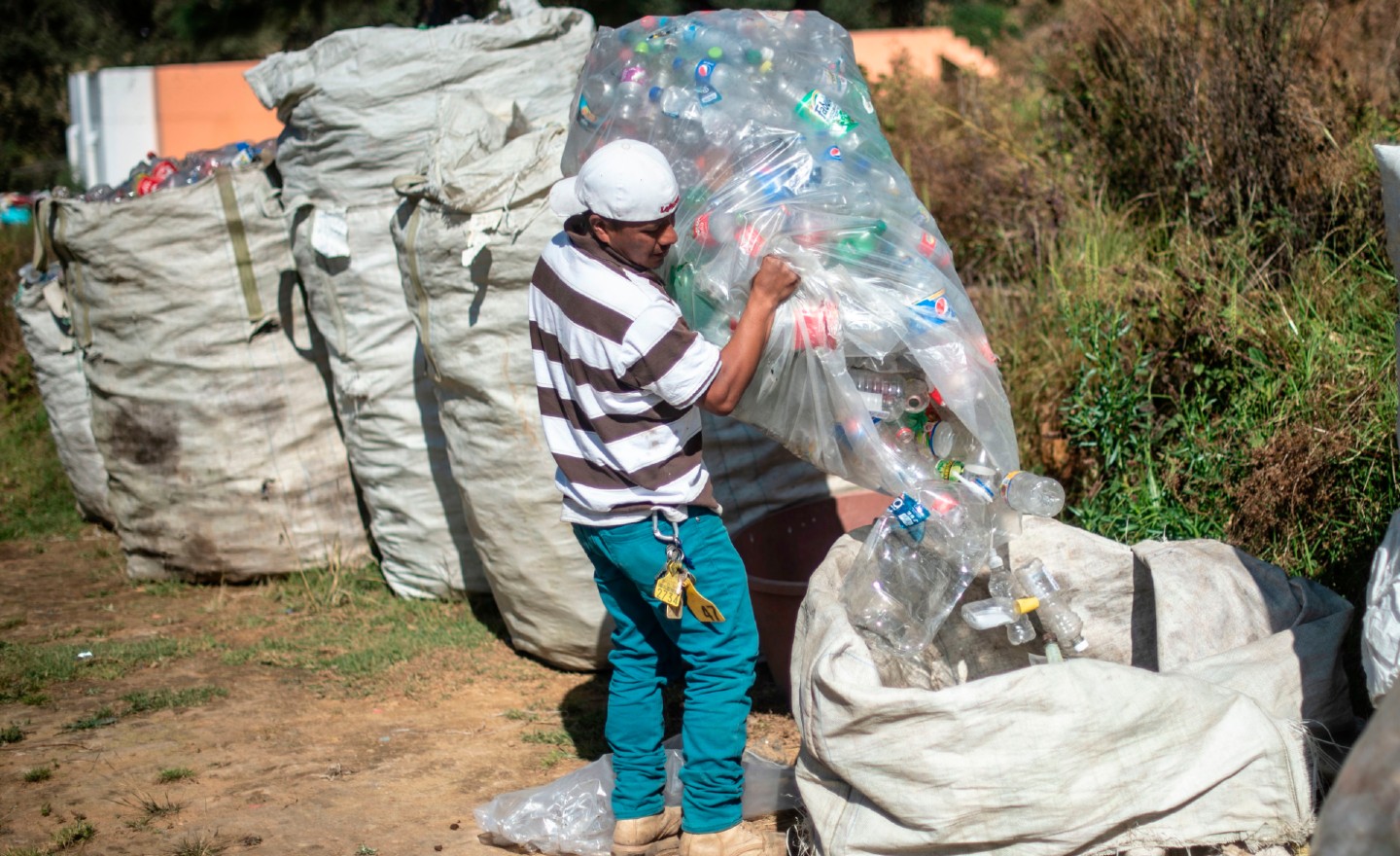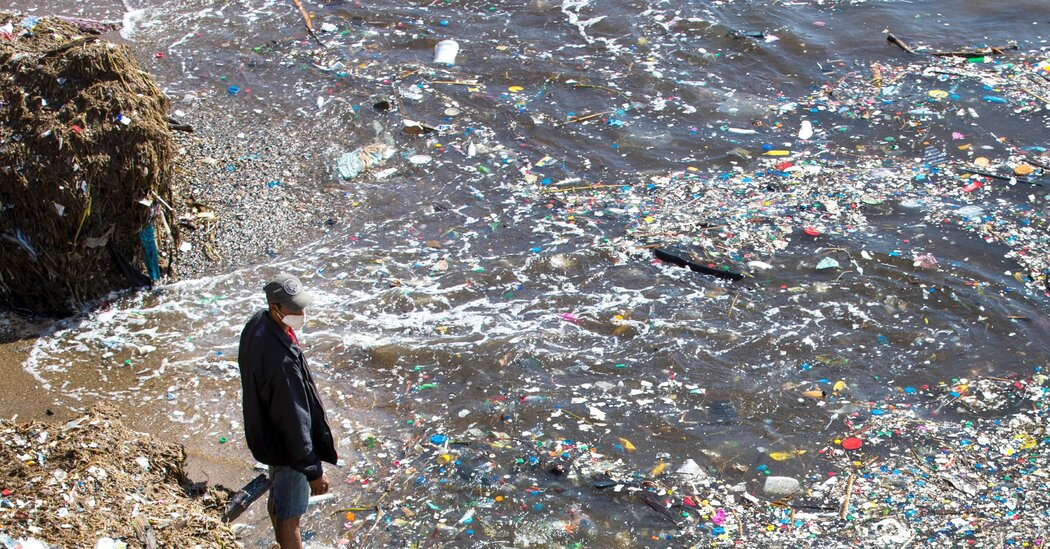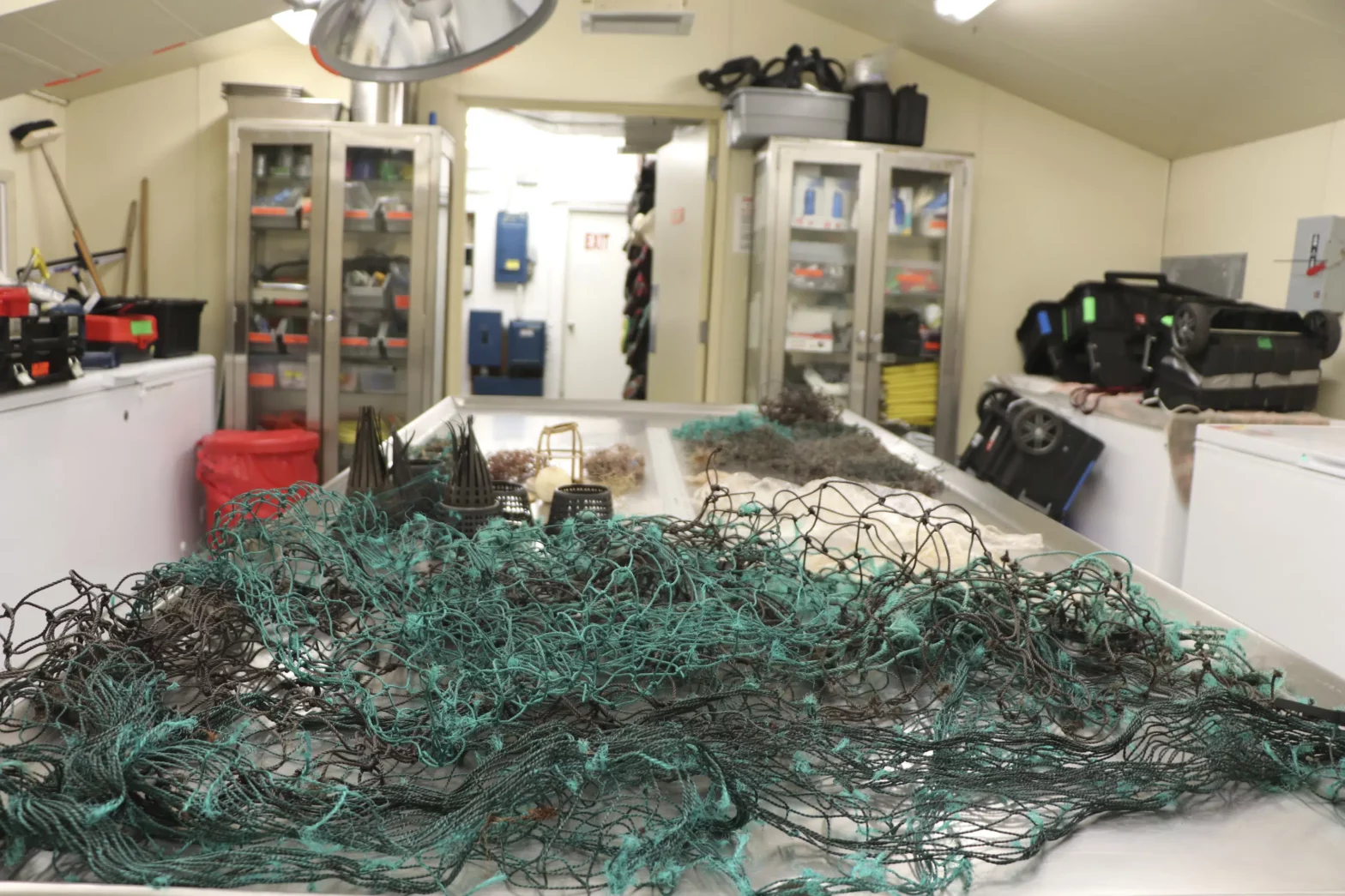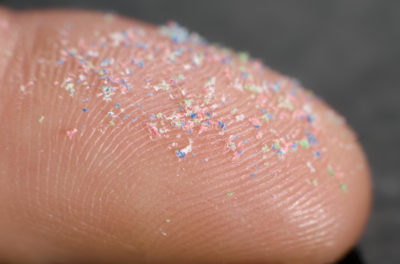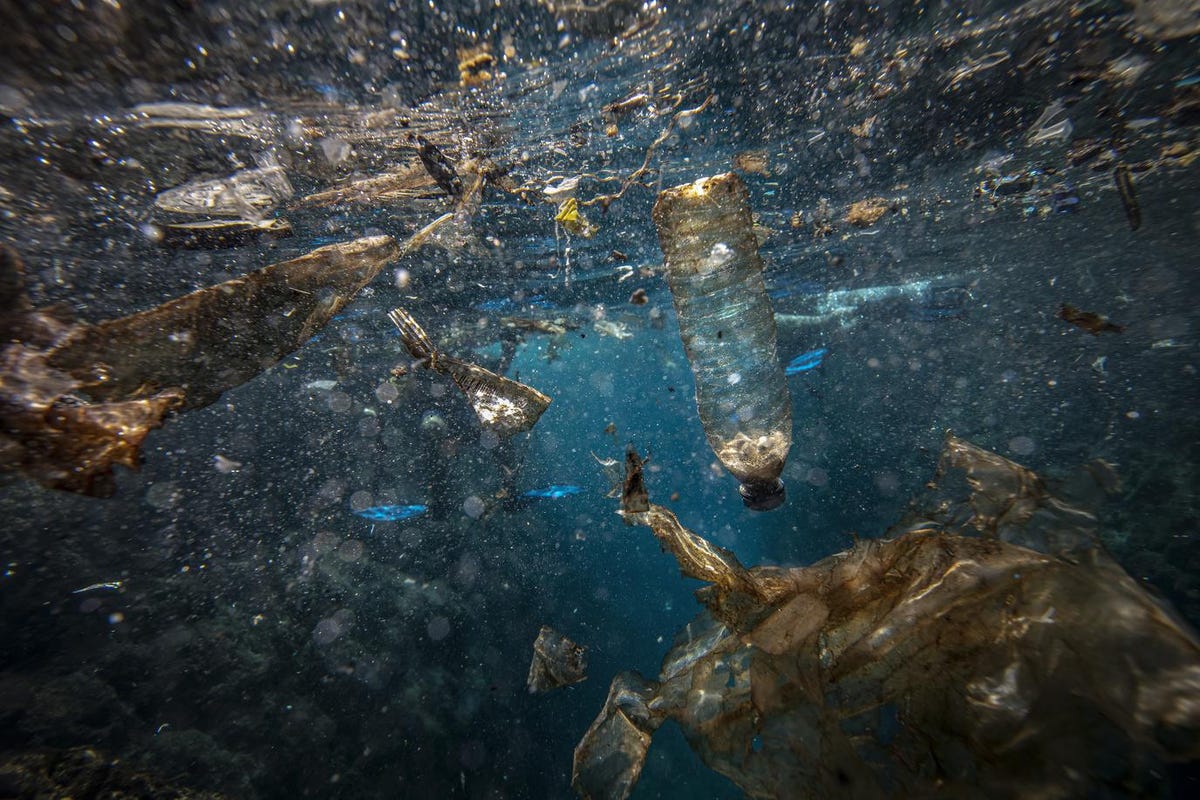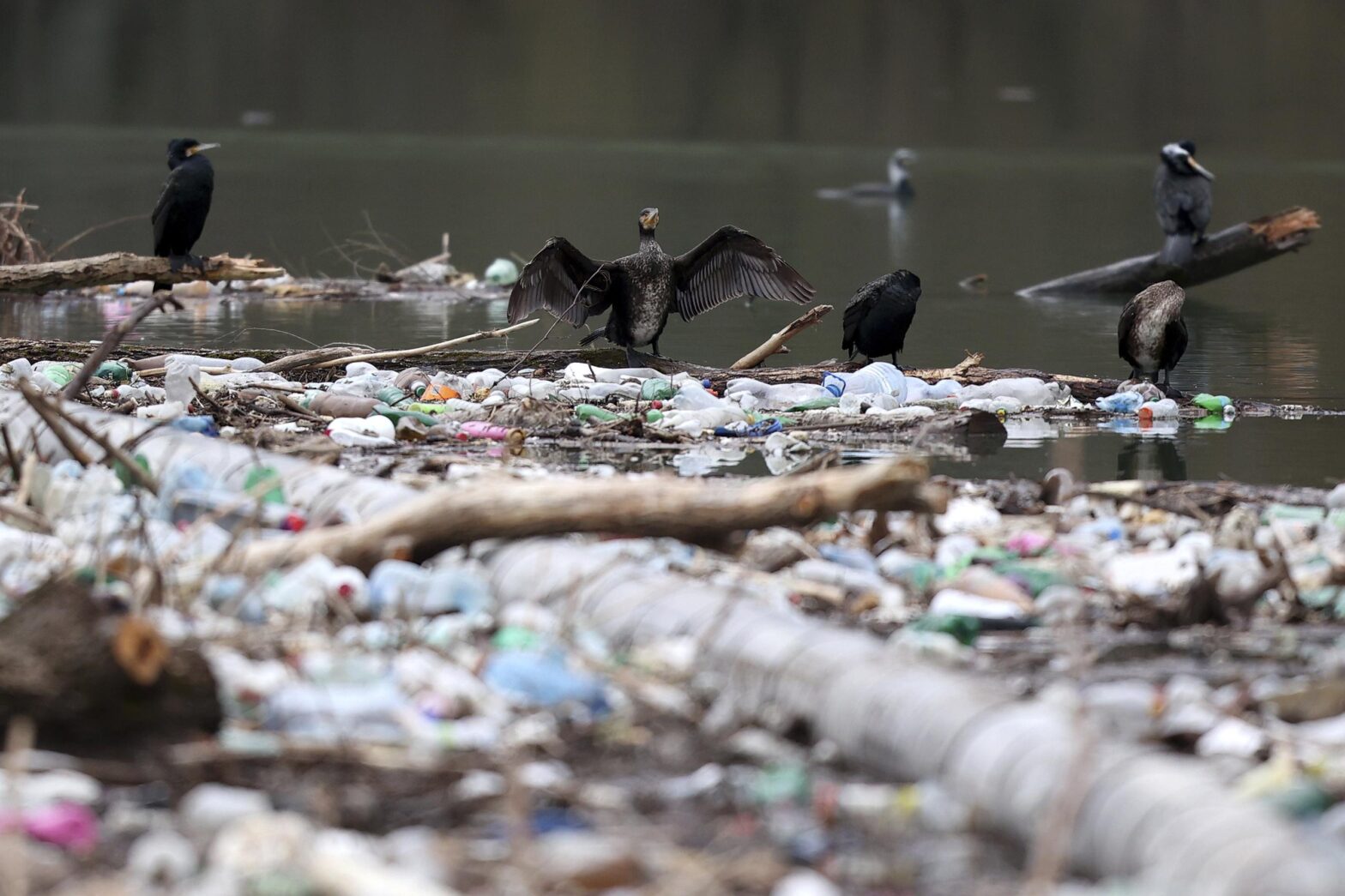Canada’s prohibition on the sale of single-use plastic bags doesn’t come into effect until the end of this year, but it’s already getting harder to find them when you’re shopping.Numerous grocery chains in Ontario have been removing traditional plastic bags as an option for shoppers who don’t bring their own.It’s part of the federal government’s ambitious zero plastic waste strategy. Canada is aiming to remove millions of tonnes of difficult-to-recycle plastic waste, as well as plastic pollution, and mandate a minimum of 50 per cent recycled content in plastic packaging.It’s a major change to the retail landscape in this country. But there are questions about the options being used to replace the ubiquitous plastic bag — and about the impact the ban will have.Many of the bags that grocery stores are selling appear to be fabric — they too are also made of plastic, are themselves unrecyclable and many are manufactured in China. The cheaper ones have no recycled content.“They use different types of plastic resins that are much stronger and have more tensile strength, and that allows the bag to be reused multiple times,” says Cal Lakhan, a York University research scientist. “But the drawback is that it requires a significant amount of resources to make that bag.“So, unless you’re using it hundreds of times, you might not actually get a positive environmental return.”The bags will also be more expensive, anywhere from $0.15 cents and up for a paper bag — which can also be difficult to recycle because of food contamination and paper quality — to $5 for a reusable plastic fabric bag or more for other materials.Single-use plastic bags are just one of the items being banned in Canada. The others include single-use food service ware, stir sticks, straws and ring carriers.The government says the regulations are meant to “prevent plastic pollution by eliminating or restricting the six categories of SUPs (single-use plastic) that pose a threat to the environment,” and to “make it easier for Canadians to enjoy the benefits of clean natural areas, and help foster the transition to a circular economy.”There are those like Lakhan who describe it as a “feel-good policy” that won’t do much to reduce our overall plastic waste.“Almost all the emphasis is placed on consumers and the residential sector,” says Lakhan. “But we’re a drop in the bucket of the larger problem. “In terms of all the waste generated, 90 per cent of it comes from the industrial sector, not from the residential sector,” says Lakhan, referring to plastic waste that enters the environment through manufacturing and industrial processes.Bans on single-use plastics, such as the one in Canada, are becoming more common around the world as jurisdictions look for ways to reduce the highly visible consumer waste that is littering shore lines. That plastic makes its way into waterways where it endangers marine life and ecosystems. It can also become brittle and breakdown into harmful microplastics, which not only contain harmful chemicals but attract others already in the environment.In the E.U., more than two-thirds of ocean litter is comprised of the 10 most common single-use plastic items found on European beaches. The union is banning the sale of those items, including cutlery, plates, straws, stir sticks, cotton bud sticks and balloons, but not bags. On other items, it will require labelling to inform consumers about the harm done to nature if the item becomes litter. The EU is also introducing waste management and cleanup obligations for producers.“Plastic bags and other single use plastics are the top items we find in the environment,” says Britta Baechler, associate director of ocean plastics research for Ocean Conservancy, a non-profit based in Washington, D.C.“They’ve been detected in the stomachs of all kinds of marine animals around the world. So they’re extremely problematic. And again, they will break up into what we call microfilm, small flexible pieces of plastic which can be ingested by any number of living organisms.”Since the 1950s, about 40 per cent of plastic produced every year is designed to be thrown away after one use, according to an article published in nature.com last year.In Canada, about 90 per cent of plastic ends up in landfills.Items like single-use plastic bags, which are made of a low-density polyethylene, are cheap to make but difficult and cost-prohibitive to recycle. And the bags, as well as other plastic film can easily be contaminated by any food it’s in contact with.“When we talk about sustainability, it’s important to remember that there is an environmental, economic and social dimension,” says Lakhan. “And we tend to just fixate on the environment.“The economic aspect of trying to recycle plastic film is once again thousands of dollars a ton,” he says. “And you have to ask yourself, is that money well spent given that the end product is still low grade and will still ultimately end up in landfills.”California has tried to create a viable system to recycle plastic grocery bags.The state banned single-use plastic bags in 2016, but allowed grocery stores to sell thicker plastic film bags, manufactured by companies in California, made of polyethylene, including 40 per cent recycled content.Grocery stores were made responsible for creating a closed-loop system, installing bins in the front of stores to collect the bags and ensuring they are recycled. The cost is born by consumers who are charged $0.10 a bag.The bags, along with more pristine shrink wrap from pallets of packaged food deliveries, were supposed to be collected and sent to distribution centres and processed into a plastic flake used for agricultural ground cover and drip tape for irrigation.But the front-of-the-store collection bins were removed during COVID and haven’t been replaced.Mark Murray, executive director of Californians Against Waste, says the companies reclaiming the bags have figured out that it’s cheaper not to have to separate the pallet wrap from the bins of potentially contaminated, used grocery bags.“It’s an economic barrier. It’s a pain-in-the-ass barrier,” says Murray. “It is, you know, folks whose job is not really recycling, but minimizing cost, who are not supporting the objectives that the retailers agreed to as part of this legislation.”The state’s attorney general is now investigating whether the reusable plastic bags are actually being recycled. Although the legislation says the bags must stand up to 125 reuses, it’s thought most are reused once — to line a garbage bin. Murray’s organization hopes the investigation will result in the bins being returned as well as proof that the bags are being recycled.So far, the Canadian ban on single-use plastic bags doesn’t have the same teeth.The regulation stipulates that reusable bags can be made of plastic fabric “as long as they will not break or tear if used to carry 10 kg over a distance of 53 m 100 times.”“The Single-use Plastics Prohibition Regulations do not contain specific testing methods, nor do they require regulated parties to provide proof of testing for single-use plastic items placed on the Canadian market,” said Environment Canada in an email. “Retailers are encouraged to discuss the requirements of the Regulations with their suppliers.”RELATED STORIESThe Canadian regulations also say the bags must stand up to a “single domestic wash.” Reusable bags should be wiped down or washed often, a recommendation because meat and dairy can contaminate the bags.But that recommendation also has the potential to add more microplastics to the environment, as washing is one of the major ways that fibres from plastic materials are released into wastewater.“There’s a possibility that laundering reusable bags at high temperatures and agitating them and everything can release microplastics because they’re created from synthetics,” says Baechler, of Ocean Conservancy.Guidelines that stipulate fewer washes between use, washing on cold temperatures, on a gentle setting, with mild detergent, could help reduce the release of microplastics, says Baechler.The good news is that some grocery chains are also pursuing solutions to reduce plastic waste.Walmart Canada eliminated single-use plastic shopping bags in April of last year and says that move has prevented more than 527 million single-use plastic shopping bags from entering circulation.The chain is trying to create a circular economy for its reusable bags, running a pilot at its Guelph store where it has installed a “GOATOTE” kiosk. Customers can check out clean reusable bags for a fee, and return them within a month, after which they are cleaned, sanitized and put back into circulation in the kiosk.Walmart says it is also reviewing opportunities to take back bags used for home delivery.And Sobeys, which held a contest last year in Atlantic Canada to find a sustainable alternative to plastic wrap on its in-store meat and seafood packaging, is working with the winner of that contest to develop a potential fibre replacement.More of those “upstream” innovations are needed to reduce our reliance on plastic, says Baechler. “We drastically need to reduce the amount of single use plastics and packaging that we produce. We need to create better. We need to find alternatives. We need more sustainable materials, and we need different delivery methods like refillable or reusable bags,” as well as recycle.“And the problem with plastic bags is they are not recyclable,” says Baechler. “They gum up the recycling equipment. So they’re hugely problematic. They’re not circular and banning these items makes people change behaviour. And that’s ultimately a piece of the solution puzzle.”SHARE:JOIN THE CONVERSATION Anyone can read Conversations, but to contribute, you should be a registered Torstar account holder. If you do not yet have a Torstar account, you can create one now (it is free)Sign InRegisterConversations are opinions of our readers and are subject to the
Category Archives: Plastic Pollution Articles & News
Jeremy Pare: Can the EPA strategically buy its way to waste reduction and increased recycling?
Can the EPA strategically buy its way to waste reduction and increased recycling? | The Hill Skip to content Getty Images The Organization for Economic Cooperation and Development (OECD) published a report last year finding that plastic pollution is quickly increasing as waste management and recycling efforts are falling short. The organization found that the …
Marcus Strom: Think plastic pollution is your own fault? That’s rubbish
February 13, 2023 — 7.00pm February 13, 2023 — 7.00pmNormal text sizeLarger text sizeVery large text sizeThe fallout from the collapse of the soft-plastics recycling programs in Australian supermarkets continues with news that millions of plastic bags kept aside for recycling are destined for landfill.And despite plastics recycling programs being common for many years, production of single-use plastics continues to surge.A stockpile of plastic bags in a Sydney warehouse. Nearly 12,400 tonnes of soft plastics have now been found in 32 locations across three states.These revelations expose more than just a failure of intent from the recyclers and the supermarkets. They show that they are more useful for greenwashing than dealing with the growing global mountain of plastics.Australians want to do the right thing to deal with plastics pollution. But the recycling schemes that have been on offer have barely touched the surface. The result? While people feel they are “doing their bit” for the environment, behind the scenes, recycling schemes make handy profits while the real global polluters are let off the hook.Central to the thinking of these schemes is that you, personally, are responsible for pollution and global warming. Yes, it’s all your fault. The same with being worried about your individual “carbon footprint” or being guilt-tripped for taking holidays.This has the outcome of demobilisation: sidetracking people from action to demand real change, while making individuals feel guilty and responsible for a planet-wide trashing of our environment.In fact, it’s not “your fault” but is a design feature of an economic system that accumulates more and more wealth for its own sake; that churns through more and more resources to feed that gluttony.Options for individuals to take their plastics and paper for recycling have been around for many years. Yet these “acts of consumer power” haven’t stopped masses of plastics forming in our oceans; a crisis so bad that the World Economic Forum in 2016 warned that plastics could outweigh fish in our oceans by 2050.Stockpiles of soft plastics found in Sydney warehouses.Credit:EPA NSWAdvertisementWhen single-use plastics were removed, supermarkets adopted “environmentally conscious” multi-use bags at 15¢ a pop.Many of these bags – worse for the environment than the bags they replaced – are used once and end up in landfill. Further, they become a revenue source for the supermarket chains. Queensland University of Technology academic Professor Gary Mortimer predicted the change to “reusable” plastic bags could deliver an extra $71 million a year in profits to retail giants Coles and Woolworths.Again, it is part of an ideology that tells people they are individually responsible for environmental degradation when in fact it is a global profits system and a few hundred companies worldwide that are trashing the planet.While the exact data are contested, a 2017 study argued that just 100 fossil fuel and cement companies contributed to 71 per cent of greenhouse pollution since 1988. Rather than tackle these polluting giants, individuals are asked to “do their bit”.Individual recycling schemes, like carbon offset schemes, have more in common with religious penance than urgent action to deal with plastics pollution or greenhouse gas emissions.As pointed out some years ago by Carbon Trade Watch and UK research outfit The Corner House, the push to make individual consumers feel guilty and responsible and pay a “little bit more” has more in common with medieval indulgences than real action on the environment.During Europe’s Dark Ages, the church told the benighted and sinning masses that the priesthood and assorted clergy had an abundance of holiness, while the individual believer was a sinner and damned to hell. But by purchasing indulgences from the church, they could transfer some of that holiness to their rotten lives, offsetting their sinful practices.Sound familiar?REDcycle does face prosecution in Victoria for failing to disclose its mountains of plastics. But the maximum fine is $165,000. Chicken feed.In NSW, the Environment Protection Authority has told Woolworths and Coles to clear the REDcycle warehouses at a potential cost of $3.5 million. Together, both companies made about $2.5 billion in profit last year.These companies will get away with a slap on the wrist. Meanwhile, oil companies continue to pump plastics into the environment, governments greenwash and climate protestors are threatened with prison.This tells us something about how seriously we are taking the climate crisis: punish the annoying Cassandras, let the real sinners off the hook.The Opinion newsletter is a weekly wrap of views that will challenge, champion and inform your own. Sign up here.Marcus Strom is a journalist. He worked as a press secretary in the Albanese government.Connect via Twitter.Most Viewed in Environment
Derailed train in Ohio carried chemical used to make PVC, ‘the worst’ of the plastics
The flames and deadly black smoke that billowed high over a small town on the Ohio and Pennsylvania border Monday were an acute reminder of a type of commonly used plastic with a particularly troublesome environmental and health record.
To prevent exploding rail cars, flying shrapnel and the uncontrolled release of killer gases, authorities vented vinyl chloride, a precursor of polyvinyl chloride, or PVC, and then burned the vinyl chloride in what officials described as a controlled manner, following Friday’s 50-car Norfolk Southern Railroad train derailment near East Palestine, Ohio, about 55 miles northwest of Pittsburgh. Local media showed dramatic video of an explosion and fire after Ohio Gov. Mike DeWine and Pennsylvania Gov. Josh Shapiro ordered evacuations.
On Tuesday, Ohio Director of Public Safety Andy Wilson said at a press conference that the fire was out and there had been no serious injuries, CBS Pittsburgh reported.
While the drama played out in Northern Appalachia, the story actually begins with an insatiable global demand for plastic and what United Nations officials describe as a “triple planetary crisis of climate change, nature loss and pollution.”
Vinyl chloride has been used to make polyvinyl chloride, used commercially to make such products as floor tiles, roofing and tents, for nearly 100 years. And there have been battles between industry and environmentalists over PVC for decades.
The versatile form of plastic that can be made to be rigid and durable for pipes, or soft and flexible for products such as intravenous bags and tubing, is no longer used as much as in the past in food packaging due to environmental health concerns. But it’s still a major building material for the construction industry, including siding and windows.
But one national environmental group, the Center for Biological Diversity, has been pressing the Environmental Protection Agency since 2014 to regulate PVC waste as hazardous. And health experts have also talked about having PVC declared a “persistent organic pollutant” under the 2001 United Nations Stockholm Convention on Persistent Organic Pollutants, a treaty that seeks to protect human health from chemicals that remain intact in the environment for long periods.
Those chemicals now litter the planet, accumulate in the fatty tissue of humans and wildlife, and have harmful impacts on human health and the environment. The U.S. has not ratified the treaty but participates as an observer.
“This derailment and explosion, while it’s not discharging PVC, it is indicative of the hazardous nature of this material,” said Emily Jeffers, an attorney at the Center for Biological Diversity. “As long as we continue to use PVC, we will continue to have accidents like this and it is entirely preventable.
“If we regulate PVC as the hazardous waste that it is, that could potentially force producers to develop materials with less toxic properties,” Jeffers added. “We lived without PVC before and I am pretty sure we can live without it again.”
Petrochemical facilities that make or use vinyl chloride or PVC are often found in communities of color in states like Louisiana, Texas and Kentucky that shoulder the health burdens from their polluting emissions.
EPA last May agreed to look into a 2014 petition from the Center for Biological Diversity to designate PVC a hazardous material, following a 2021 lawsuit seeking the same designation.
In January, the agency made a tentative decision denying the request, arguing that regulations would not have a meaningful impact while adding that the agency didn’t have the time or resources to create new PVC regulations. A public comment period closes Monday.
Like other chemicals, PVC has its own lobbying group in Washington. Called the Vinyl Institute, it touts the benefits of vinyl and the vinyl industry, which it said encompasses nearly 3,000 vinyl manufacturing facilities, more than 350,000 employees and an economic value of $54 billion.
PVC and vinyl are the third most used plastics in the world, according to the institute, which says on its website: “We are fiercely committed to achieving the policy agenda that helps the U.S. vinyl industry grow and create jobs.”
PVC has been used a lot, said Dr. Philip Landrigan, a pediatrician, epidemiologist and director of Boston College’s Global Public Health Program and Global Observatory on Planetary Health. But, he added, “it has problems at every stage” of its lifecycle, beginning with potential dangers to workers who make it.
Vinyl chloride is classified as a known human carcinogen. Researchers in the 1970s first linked its occupational exposure to a rare form of cancer—angiosarcoma of the liver—to rubber workers at a factory in the Rubbertown complex of chemical plants in Louisville, Kentucky. “There’s also some evidence it causes brain cancers,” he said.
PVC also contains a variety of chemical additives, such as phthalate plasticizers, some of which are blamed for disrupting the human endocrine system.
“There is good evidence” that toxic ingredients in PVC “can leach out of plastics products and get into drinking water or blood products,” said Landrigan, whose research has helped drive U.S. public health policies on childhood lead exposure, pesticide exposure and the response to health impacts of 9/11 rescue workers in New York.
The industry has disputed such assertions. A 2017 report, for example, from the PVC Pipe Association maintains that PVC piping meets the “highest standards for quality and safety.”
Vinyl Institute spokeswoman Susan Wade said that PVC can and is being recycled, and according to the institute’s website, the industry has a goal of boosting the recycling of vinyl materials. “We know we have a good story to tell,” she said, pointing to a lifecycle carbon emissions study from McKinsey & Company that shows using PVC sewer pipes has less impact on the climate than using pipes made from concrete or iron.
Keep Environmental Journalism AliveICN provides award-winning climate coverage free of charge and advertising. We rely on donations from readers like you to keep going.Donate Now
Guess what? More plastic trash.
Industry figures show record production in 2021, and almost none of that plastic is getting recycled.When Exxon Mobil announced a record $56 billion annual profits last week, it noted that the company had established “one of the largest advanced recycling facilities in North America, capable of processing more than 80 million pounds of plastic waste per year.”That seems like a lot of recycling muscle, except when you consider another figure. The company produced an estimated 6 million metric tons, or 13.2 billion pounds, of polymers used to make plastic in 2021 alone. That is an estimate from a report published by the Minderoo Foundation, set up by the Australian mining magnate Andrew Forrest. Minderoo tracks plastic waste and campaigns against it.Exxon is the largest producer of virgin polymers, which are derived from petrochemicals and used in plastic. The second largest is a Chinese company called Sinopec.Asked for comment on the Minderoo report, an Exxon spokeswoman said that “plastics play a vital role in everyday life” and that the company is trying to scale up recycling. “By working with others in industry, governments, communities and consumers, we are helping expand recycling programs so that more plastic waste is transformed into valuable products rather than ending up in landfills.”Despite consumer concern, we are trashing more and more plastic.Plastics production continued to grow, according to industry data. So did plastic trash: 139 million metric tons in 2021, more than ever before. That’s a lot, especially considering that plastic entered our everyday lives after World War II. They’re so pervasive that when one reporter tried to spend a day living without plastic, it yielded this delightfully absurd essay.Almost all of that 139 million metric tons of plastic is made from “virgin” petroleum products that have never been used or processed before. Barely 2 percent gets recycled, Minderoo researchers estimated.Plastic waste is more than a local environmental pollutant.It clogs streams. It chokes turtles. It gets caught on a bare branch and blows in the breeze. It stews in landfills.But it is also a climate pollutant. From the extraction of fossil fuels to make polymers to the transport and disposal of the waste, single-use plastics produced 450 million metric tons of planet-warming greenhouse gases in 2021 alone, according to estimates by Minderoo, or just below the annual emissions of Britain.Minderoo is pressing for levies on “fossil-fuel polymer production and/or consumption” to fund the collection and recycling of plastic waste.A factory in Riverside, Calif., that makes plastic containers for fruit retailers.Mark Abramson for The New York TimesWhat about those triangles and arrows on plastic products?They’re deceptive. Many of us assume the ♺ triangle means we can dispose of the product in our municipal recycling bins. Not so. Each triangle has a number within. Numbers 1 and 2 are commonly recyclable in the United States. For Numbers 3-7, it’s sometimes, rarely or never. (California banned the use of the symbol on plastics that are not widely recyclable.)Rigid plastics are more likely to be recycled than soft plastics.Some of the worst kinds of plastics are also those products that are marketed to the poor, especially in the global south, like tiny, low-priced sachets for shampoos and creams. They’re made of soft, thin plastic that’s hard to collect, sort and recycle.Here’s our guide from last year, and an earlier Climate Forward newsletter that describes how some cities outside the United States are handling plastic waste.And the plastic bag bans?There have been many such bag bans in recent years. Among the unexpected consequences: They seem to lead to an increase in plastic trash bags.We’re keeping an eye on negotiations for a global plastics treaty.This is the battleground where plastic producers, environmentalists and negotiators from every country are hammering out what is intended to be a global agreement to deal with plastic waste.The big tension is between environmental campaigners who want to curb the production of polymers, the raw goods that go into plastic, and industry groups that want to focus on how to better collect and recycle plastic.At negotiations in Uruguay in December, the United States advocated for an accord like the Paris climate agreement under which countries would set their own national voluntary targets and plans. Others, including the European Union, want mandatory global regulations for every country and company to abide by.The next round of negotiations are in May. We’ll keep you posted.Essential news from The TimesAidan Colton, an atmospheric technician with NOAA, collected an air sample atop Mauna Kea in Hawaii.Erin Schaff/The New York TimesLava, snow and science: An eruption in Hawaii briefly halted long-running climate research, but scientists found a way to carry on. They moved to a neighboring volcano.A warship’s demise: The Brazilian Navy said it had begun an operation to send the aircraft carrier São Paulo, packed with asbestos, to the bottom of the Atlantic.Bad news for bears: The Biden administration is taking a step toward lifting protections for some grizzlies. It could open the door to hunting in Montana, Wyoming and Idaho.A Canadian quarrel: The Ontario provincial government has opened up parts of the greenbelt around Toronto for the construction of 50,000 new homes. Some locals aren’t happy.How to spy on a radical group: A literary agent struck a book deal with the spokesman for the Earth Liberation Front. Literature was the least of his concerns.From outside The TimesAccording to Axios, sales of plant-based meats are collapsing and companies that make them are in trouble.Reuters reported on deadly forest fires in Chile.The United Arab Emirates chose an oil executive to lead the next global climate summit. Now The Guardian is reporting that officials are giving oil workers other roles, too.From E&E News: President Biden has appointed a climate scientist to help evaluate the effectiveness of the country’s intelligence work.National Geographic interviewed former poachers of scarlet macaws in Honduras about why they decided to protect the birds instead.A short documentary from Scientific American shows why some scientists believe plants domesticated us, not the other way around.Carbon brief explained how Britain transformed its electricity supply in just a decade.Maria ChimishkyanBefore you go: So many questions. We’ve got answers.A few months ago we invited readers to ask us their questions about climate change, and you sent in more than 1,000 responses. Wondering what we did with all those questions? We used them to build an interactive F.A.Q. feature that lets you type in queries about climate change, in your own words, and get answers written by The Times’s climate reporters and editors. Please give it a try.We goofed: The Friday newsletter misstated the name of an advocacy group. It is Rewiring America, not Rewriting America.Thanks for being a subscriber. We’ll be back on Friday.Manuela Andreoni, Claire O’Neill and Douglas Alteen contributed to Climate Forward. Read past editions of the newsletter here.If you’re enjoying what you’re reading, please consider recommending it to others. They can sign up here. Browse all of our subscriber-only newsletters here.Reach us at climateforward@nytimes.com. We read every message, and reply to many!
Have climate questions? Get answers here
By some estimates, the world’s food system is responsible for one-quarter of humanity’s greenhouse gas emissions. It happens because forests get cleared to make room for farms and livestock. Cows and rice paddies emit methane, a potent greenhouse gas. Fossil fuels are burned to power farm machinery, make fertilizer and ship food.Anyone focused on the climate effects of diet should keep a few broad things in mind. First, beef, lamb and cheese tend to have the biggest effects on emissions by far — creating the most greenhouse gases per gram of protein — in part because cows and other ruminants are more resource-intensive to raise. Pork, chicken, eggs and many types of fish typically have smaller effects on emissions (though they can create other environmental concerns). Plant-based foods usually produce the fewest emissions of all.So the most straightforward way of reducing diet-related emissions is to consume less meat and dairy and more plants. It’s especially the case if you live in the United States, where red meat consumption is much higher than in many parts of the world.According to a World Resources Institute analysis, if the average American simply replaced a third of the beef they eat with lower-emissions pork or poultry or legumes, their food-related emissions would fall 13 percent. Moreover, a number of studies have found that people who currently eat a meat-heavy diet could shrink their food-related footprint by one-third or more by going vegetarian.It sounds like a no-brainer, but the other big way to shrink the climate effect of your diet is simply to waste less food. According to some estimates, Americans throw out roughly 20 percent of the food they buy.Other popular strategies are less clear-cut, at least when it comes to greenhouse gas emissions. Studies differ on whether grass-fed beef, for instance, is any more climate friendly than conventional feedlot beef, although some argue it’s better for animal welfare. Organic crops tend to require more land than traditional crops, which could lead to more emissions if such farming results in more deforestation. As for debates over locally grown produce, or paper vs. plastic bags, those are relatively small in the grand scheme of things, since transportation and packaging are a sliver of food’s climate effects.And, of course, there are other concerns besides climate change.For example, when compared with meat, wild fish can be a lower-emissions option. But that comes with a caveat: The world is already catching about as much wild fish as it possibly can. Most fisheries are being fished at their maximum sustainable level, while others are being overexploited. So more people switching to fish could require, among other actions, increasing the number of sustainable fish farms worldwide.
— Brad Plumer
Read more:
Your Questions About Food and Climate Change, Answered
Hawaii whale dies with fishing nets, plastic bags in stomach
HONOLULU (AP) — A whale that washed ashore in Hawaii over the weekend likely died in part because it ate large volumes of fishing traps, fishing nets, plastic bags and other marine debris, scientists said Thursday, highlighting the threat to wildlife from the millions of tons of plastic
Microplastics are filling the skies. Will they affect the climate?
Recent studies reveal that tiny pieces of plastic are constantly lofted into the atmosphere. These particles can travel thousands of miles and affect the formation of clouds, which means they have the potential to impact temperature, rainfall, and even climate change.
Nets, plastic, underwater crime
We’ve all seen them. Images of countless turtles, whales, dolphins, sharks, and seals, dead and entangled in abandoned fish nets. The ocean is becoming an increasingly dangerous place for its inhabitants. And not because of the ‘eat or be eaten’ laws of nature – but because just by nature of being a creature that swims, you’re likely to eat plastic that may kill or maim you, or end up trapped and entangled in a net, left to struggle in an unnatural death until you starve, suffocate, or become prey.
It’s one thing to talk about statistics and science, but the violence, pain and suffering our throwaway plastic culture has caused is something that can’t be measured in numbers.
The ocean has become a crime scene. Currently, there are an estimated 50-75 trillion pieces of plastic and microplastics in the ocean. The plastic either ends up forming giant garbage patches, or breaking down into microplastics.
Plastic waste makes up 80% of all marine pollution and an estimated 8-10 million metric tons of plastic waste end up in the ocean every year. If current trends continue, by 2050, plastic is expected to outweigh all fish in the sea.
Imagine going for a seaside holiday and swimming in an ocean of plastic? Imagine a sea devoid of life – the magnificent underwater world destroyed because we treated the ocean like a giant garbage dump?
In just the last decade, humanity produced more plastic than it did in the last century. In most supermarkets, fruit and vegetables are wrapped in single-use plastic packaging, but every piece of single-use plastic takes between 500 -1,000 years to degrade. And when it degrades, it does not decompose, it becomes microplastics which are poisonous to animals and humans.
The Environmental Protection Agency has stated that 100% of all plastics human beings have created still exist.
One of the most harmful types of marine plastic debris is abandoned, lost, discarded fishing gear. About 640 thousand tons of fishing equipment get dumped into the ocean each year, not only entrapping marine life, according to researchers from the WUN Global Research Group, “there is chemical contamination with disruptive effects on marine species. As a result, human health is also impacted, with marine litter serving as a vehicle for diseases that contaminate the food chain.
“The problem is more visible in Asian countries like Taiwan, which has one of the world’s largest fishing fleets. In Taiwan, an average of 12.7 m3 of marine litter accumulates per kilometer along the coastline, 70% of which is caused by fishing gear.”
Each year, an estimated 100,000 sea animals are killed by plastic, around 90% of seabirds have eaten plastic, and one in every three sea turtles.
In a study that examined how to stop fishing gears from turning into ocean waste, scientists recommend not only better monitoring and managing of data on fishing gear waste streams by governments, but also regular meetings between stakeholders including the fishery sector, government agencies and non-governmental organisations to share knowledge and work towards implementing solutions for more sustainable fisheries.
Ocean plastic removal initiatives range from The Ocean Clean up, which aims to remove 90% of the plastic in the ocean both by scaling solutions to remove debris from the ocean and to intercept plastic in rivers before it reaches the ocean.
1% of the world’s rivers – 1,000 rivers – are responsible for 80% of the plastic that flows into the oceans, so stopping plastic trash has to start with cleaning up rivers.
Ocean plastic removal initiatives like non-profit organisation The Ocean Clean up have developed a range of interceptor solutions to tackle the plastic trash in rivers, from building a simple ‘trash fence’ across a river to high-tech, solar powered filtration systems. The Ocean Clean up has removed an impressive 2 million kilos of trash so far.
A sailor and surfer led Dutch startup created a low-cost, low-tech solution for stopping plastic trash from entering the oceans. The Great Bubble Barrier’s (GBB) beauty is in its simplicity: a perforated tube is embedded on riverbeds, creating a curtain of bubbles which gently nudges waste to the riverbank where it can be collected.
Ichthion was first developed at London’s Imperial College. The company has developed three types of technologies to remove plastics from rivers and oceans: a barrier for plastic capture in rivers, a plastic extraction system for marine environments, and a technology which can be retrofitted to large ships for plastic removal.
River Cleaning designed a diagonal line of floating rotating cog-type devices that pass the waste along the chain until it reaches a storage area by the river bank. This ingenious technique uses the flow of water in the river to spin the cogs – so no power is required.
And while upscaling ocean clean up solutions is urgently needed in coming years, the challenge remains to tackle the problem at its root cause.
Searious Business helps companies adapt their plastic packaging towards more sustainable supply chains and business models, while innovative startups like Apeel and Geno are bringing plant-based alternatives to plastic to disrupt plastic packaging and the plastic-based fast fashion industries.
The movement to include rescuing the ocean as part of our global efforts to tackle climate action is growing. Leaders from Australia, Canada, Chile, Fiji, Ghana, Indonesia, Jamaica, Japan, Kenya, Mexico, Namibia, Norway, Palau and Portugal have joined forces to form the High-Level Panel for a Sustainable Ocean Economy to accelerate ocean protection in policy, governance and finance. The ocean as we know it is a ticking time bomb – an accumulating trap of debris and toxins that are being carried into and poisoning the food chain. But hope stems from the growing awareness and accountability for how human survival depends on our ability to care for and protect the natural world.
Serbia, Montenegro, Bosnia do little to solve waste problem
PRIBOJ, Serbia (AP) — In southwest Serbia, construction machines are being repurposed to clear tons of waste clogging the Potpec lake. Year after year during the winter months, the lake near the southwest Serbian town of Priboj fills with tons of garbage such as plastic bottles, rusty barrels, dead animals and even furniture or home appliances. That’s because the Lim river feeding into the lake swells during the winter months and sweeps up trash from dozens of illegal landfills along its banks, as it flows from Montenegro to Serbia. It’s much the same in neighboring Bosnia’s Drina river into which the Lim eventually flows. The problem spans decades and stems from poor waste management and a general lack of environmental protection safeguards across the Balkans. Workers clearing the garbage with small cranes at the Potpec lake this week said the machines often break down because there is simply too much trash. Moreover, the cranes just weren’t designed to pick up large chunks of wood or heavy washing machines from the water. ADVERTISEMENT “You would not believe the things people throw into the river,” said Milan Visic, a tugboat pilot. “It is in fact much better now than it was before because we cleaned up a lot.”The workers say they have collected some 10,000 cubic meters (more than 353,000 cubic feet) of waste since early December. But their job is far from over as much more garbage remains piled up in the lake. . Officials from Serbia, Bosnia and Montenegro have on several occasions pledged to work together to solve the problem affecting their shared rivers but little has been done in reality. All three countries are aspiring to join the European Union and are expected to do more for to protect their environment if their accession bids are to move forward. Another pressing issue is the extremely high level of air pollution affecting a number of cities in the region.The garbage problem is evident everywhere – piles of waste dot hills and valleys, trash lines roads and plastic bags twist from tree branches. Compounding the problem is that collected trash is simply dumped in a landfill and recyclables are hardly ever seperated.Environmental activists say tough action is needed now. “For a start, heavy fines should be slapped,” for throwing waste around, said Sinisa Lakovic of the local Jastreb group.


